Introduction (Click here or scroll down for Images)
History
John Hume of the SDLP and Gerry Adams of Sınn Féın had been in communication since the late 1980s, facilitated by Father Alec Reid, who also served as an intermediary with the Irish government. In late 1993, the British government admitted it had been talking with the IRA. The Downing Street Declaration was made by the governments of the UK and Ireland in December, 1993. The Declaration stipulated that the fate of Northern Ireland lay with the people of Ireland, north and south, and allowed political parties connected to paramilitaries to participate in talks if violence were abandoned.
The IRA called a ceasefire on August 31st, 1994. A loyalist ceasefire followed on October 13th. The question for the next year and more was whether Sınn Féın and loyalist parties such as the UDA-associated Ulster Democratic Party (UDP) would be admitted to talks while they retained their weapons. The Mitchell Principles of January 1996 described a “twin track” process by which decommissioning and talks would proceed simultaneously, as opposed to the full decommissioning that had now become the policy of UK Prime Minister John Major’s unionist-backed minority government. After almost a year and a half, the republican ceasefire ended on February 9th, 1996.
Muraling
This page presents image of murals and graffiti relating to the move towards peace talks and the issues that republicans thought important going into talks: removing British forces, releasing political prisoners, disbanding the RUC, and investigating allegations of collusion between loyalist paramilitaries and security forces. Republican paramilitary murals are not painted and instead replaced by cultural murals and murals about peace and the conditions for peace. Loyalist muraling continues as before, with the addition of some murals about the peace process.
A new feature of murals during this period in terms of style and composition was the use of borders, sometime with “medallions” on top. The border – often Celtic knotwork – would act as a frame for the central image, making it look like a traditional gallery painting and intensifying the internal colours. See the Great Hunger mural and the list of cultural murals in Ardoyne at the bottom of this page. (See Visual History 01 for the use of borders in pre-Troubles PUL murals.)
Medallions (circles or ovals) provide a more elegant solution to the presentation of subjects with multiple features. Compare below, for example, End British Collusion and Fag Ár Sraıdeanna. The former puts multiple elements in direct juxtaposition, with police, loyalist paramilitaries, documents, a gun, flags, shell casings, and a graveyard scene overlapping one another. The latter depicts five conditions for peace, the main one (removal of British troops) at the centre and then four more around it in their own self-contained spaces.
Images
The phrase “give peace a chance” was popularised in a 1969 anti-Vietnam War song by John Lennon/Plastic Ono band (youtube). Bishop Street, Derry.
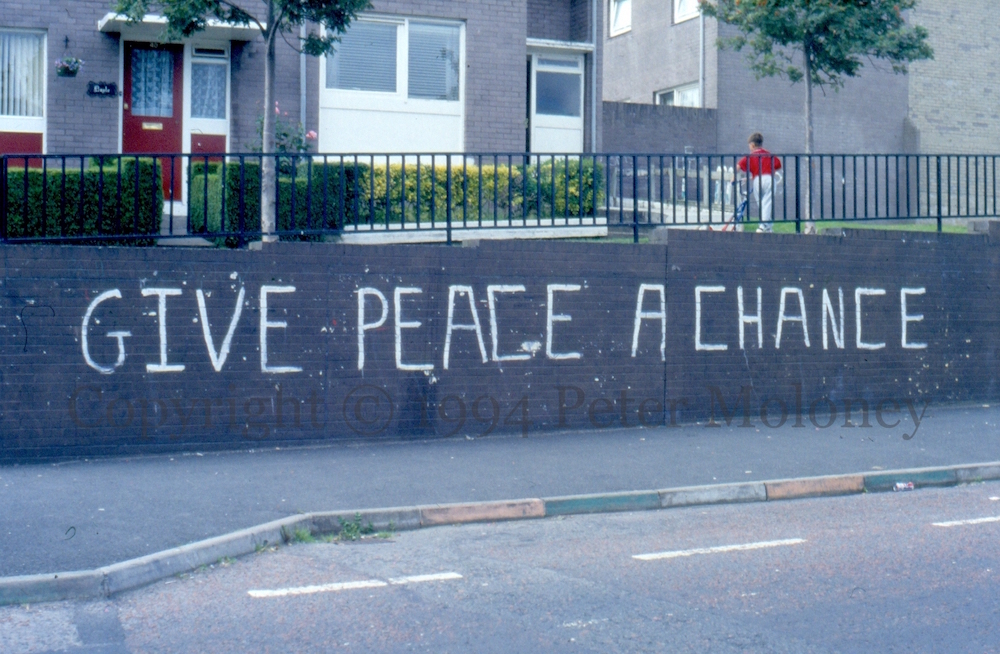
“The real initiative”. Portraits of John Hume (SDLP) and Gerry Adams (Sınn Féın) Coil in Creggan, Derry.
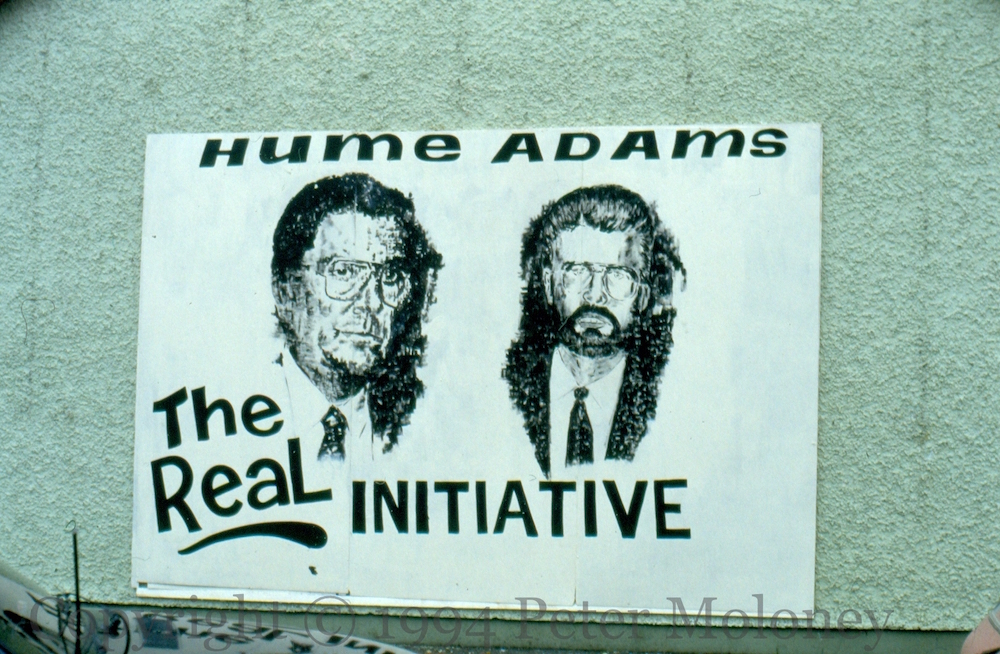
The prospect of peace talks immediately suggested to many republicans the removal of British troops (though not a united Ireland). This circular design “25 years – Time for peace, time to go” was prominent. This example is on the Sınn Féın office on the Falls Road, Belfast.
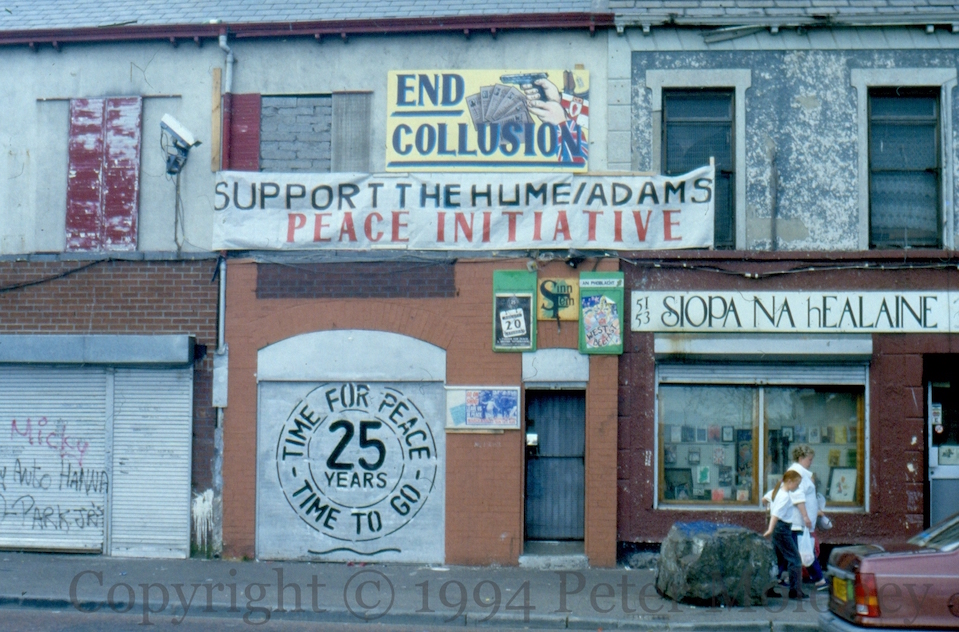
The phrase was used by cartoonist Cormac (Brian Moore), who showed a British soldier being lifted from Ireland to England by a dove (painted as a mural by Mo Chara Kelly). The image of the dove, seen on a few occasions on the previous page, is now ubiquitous. (There is a separate Visual History page tracking the relative frequency of larks and doves before, during, and after the ceasefire.)

In this Derry board, the exodus is not just of the occupying Army but of the discriminating police force, the unjust judiciary, and exploitative commerce. “Britain, time to go.”

The most popular image depicting the withdrawal of troops was a piece by Robert Ballagh, “Slán Abhaıle”, which reframed a famous photograph of British marines marching (“yomping“) towards Port Stanley in the Falklands (in 1982) so that it looked as though they were leaving Ireland for London: Britain’s great military success of recent times used to symbolise its military failure. This example is on Racecourse Road, Shantallow, Derry.

This one was painted on the back of Free Derry Corner. Others were painted in the Short Strand area of east Belfast (M01691), in Letterkenny, Co. Donegal, Ireland (M01297; see also M01299), and above the Sınn Féın offices in Belfast (M01236).
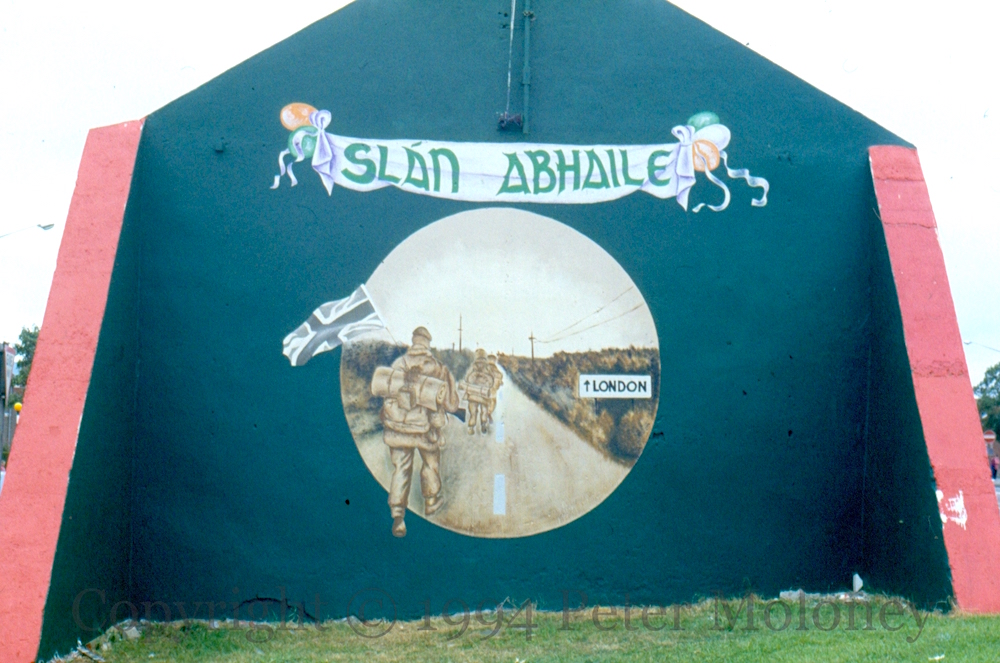
“Fag ár sraıdeanna” (“Leave our streets”) painted on, and depicting, the Whiterock Road, Belfast. They are clearly “our” (i.e. CNR) streets because of the Easter Rising mural (1991 M01002) behind the soldier’s left shoulder. The four small circles in this modified version of Slán Abhaıle list four additional nationalist demands: end collusion, release POWs, disband RIR/RUC, end unionist veto.
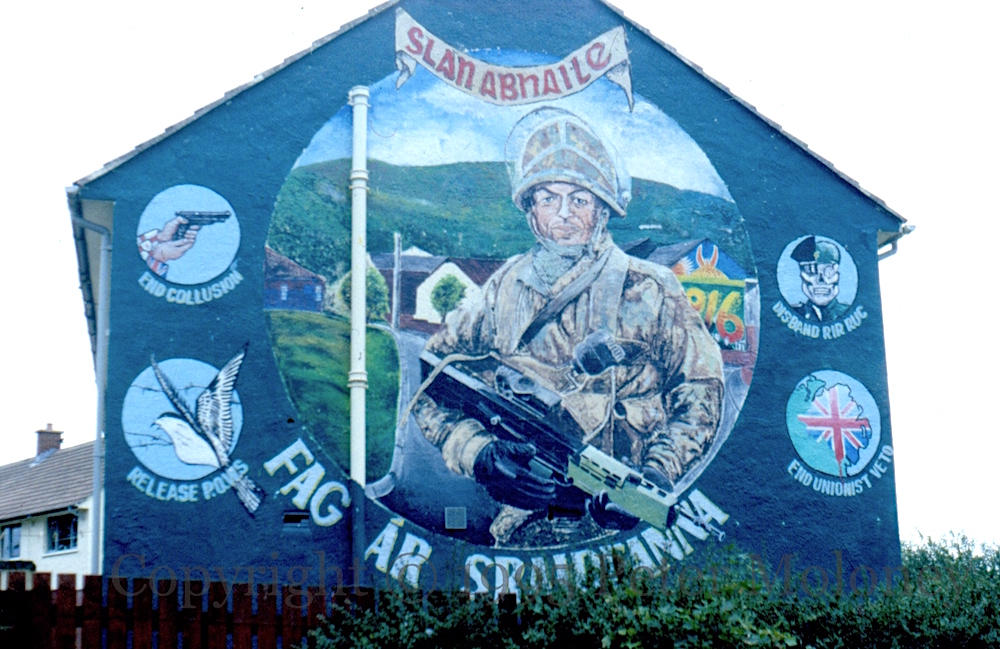
A more extensive list of conditions for peace appears in this Beechmount mural. It replaced one of the few remaining murals with weapons or gunmen (M01067).

“We won the war – Victory to the IRA”. Graffiti on the Shankill alternatively read, “We accept the unconditional surrender of the IRA – UVF.” (R2090)

Collusion
“End British Collusion”

“RUC/UFF expose collusion” in Ballycolman, Strabane.

Political Prisoners
The “Green Ribbon” campaign for the freedom of republican political prisoners is perhaps the most frequent image from 1995 to 1998. The hope of having family and friends back again appears to have been a great desire of republicans who had been through a long war.
“Release The Prisoners Of War Now”. Racecourse Road, Derry.


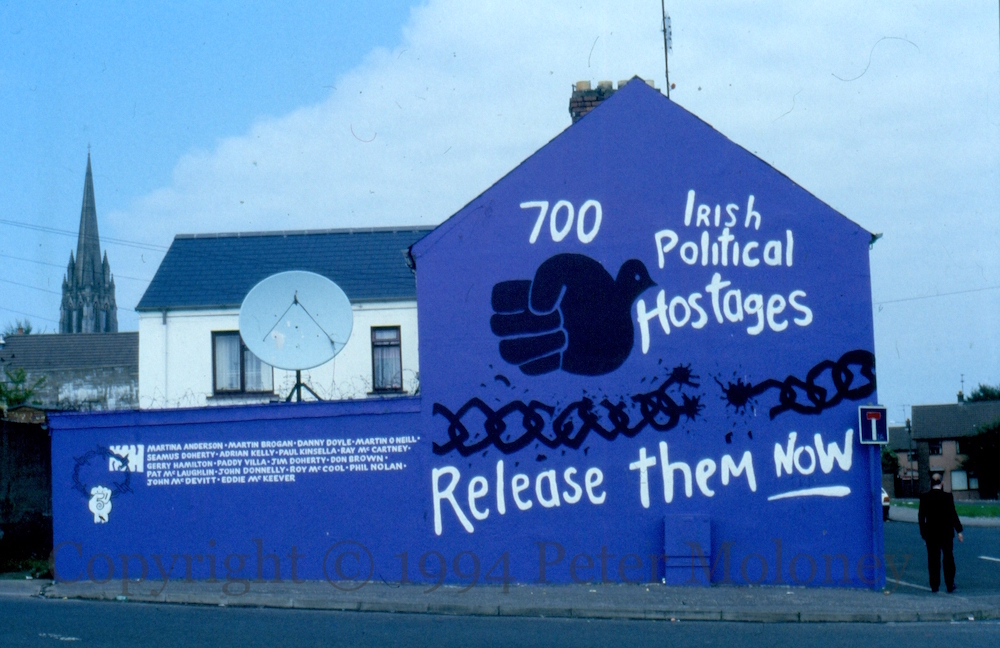
Prisoners from the New Lodge area of Belfast.
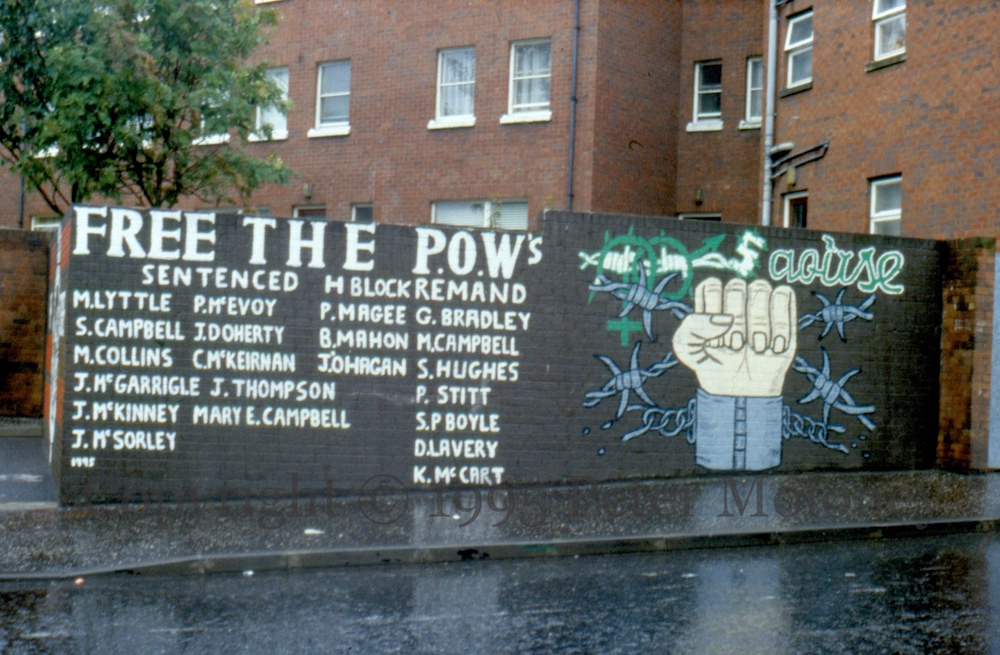
Freedom (“saoirse”) for all political prisoners in English (“Free all political prisoners”), German (“Lasser sie alle politische gefangener jetzt frei”), and French (“Liberté pour les prisonniers”), aimed at tourists in Letterkenny, Ireland.
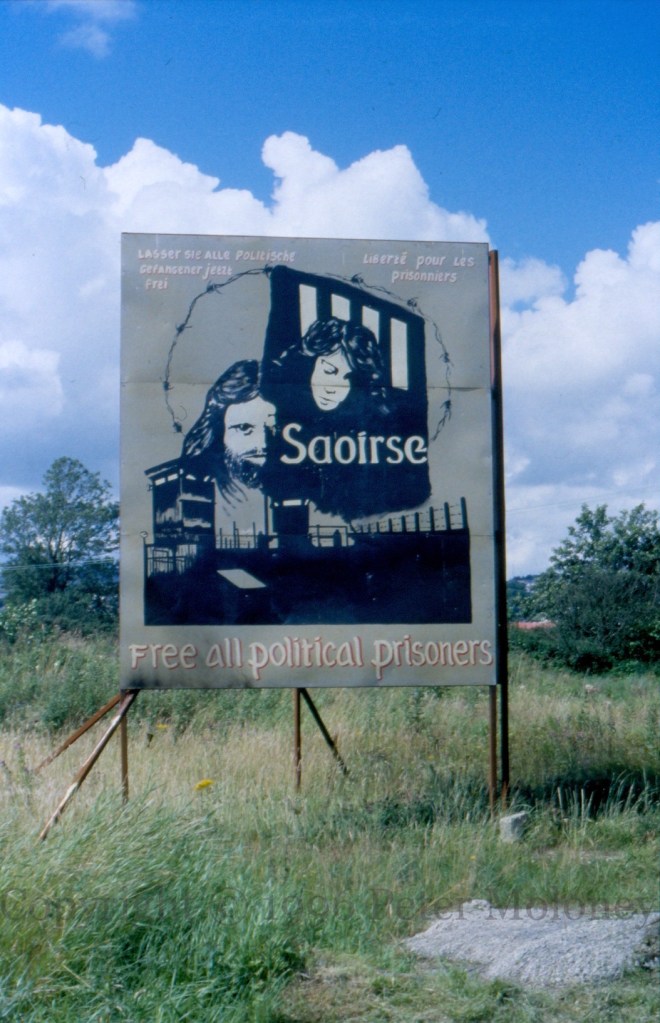
Prisoners under other jurisdictions were mentioned in graffiti:
1995: Paddy Kelly M01218, M01219, M01220; “prisoners in English jails” M01222; Mick O’Brien M01223
1997: “Repatriate all Irish political prisoners now” M02094; Roisin McAliskey M01314 M01337
Paratrooper Lee Clegg was freed on July 3rd, 1995, after four years of a life sentence for killing a joyrider on the Glen Road, Belfast. His release provoked a number of graffitis but not murals. If there was to be freedom for British soldiers convicted of war crimes, the thought ran, then there should be freedom for all.
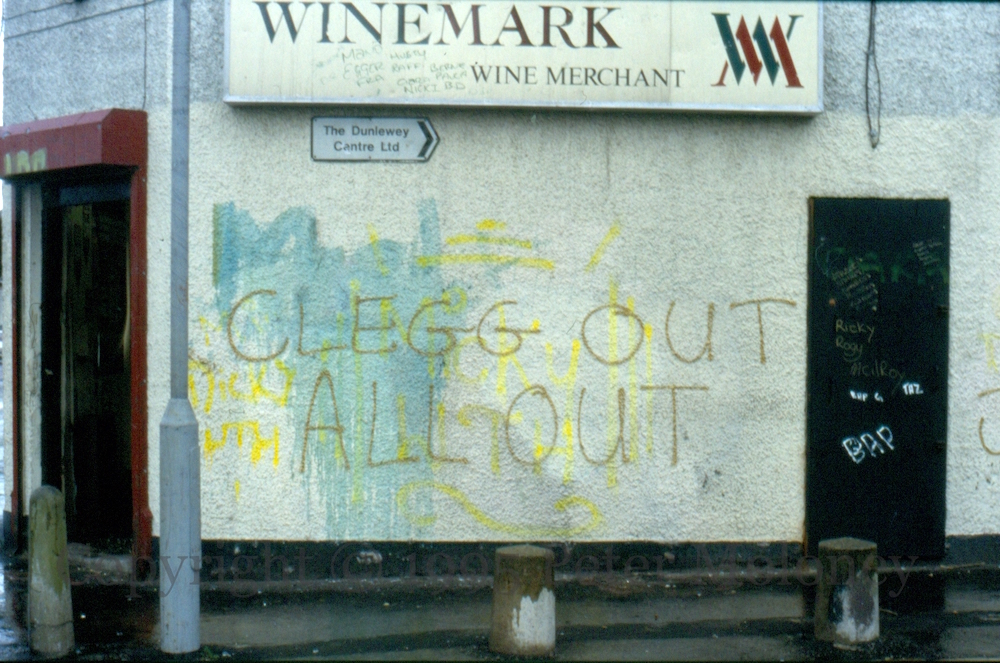
Freedom would also include loyalist paramilitaries incarcerated in Long Kesh. This mural is from the (PUL) Shankill.

Disband The RUC
Graffiti in Creggan Hill, Derry.
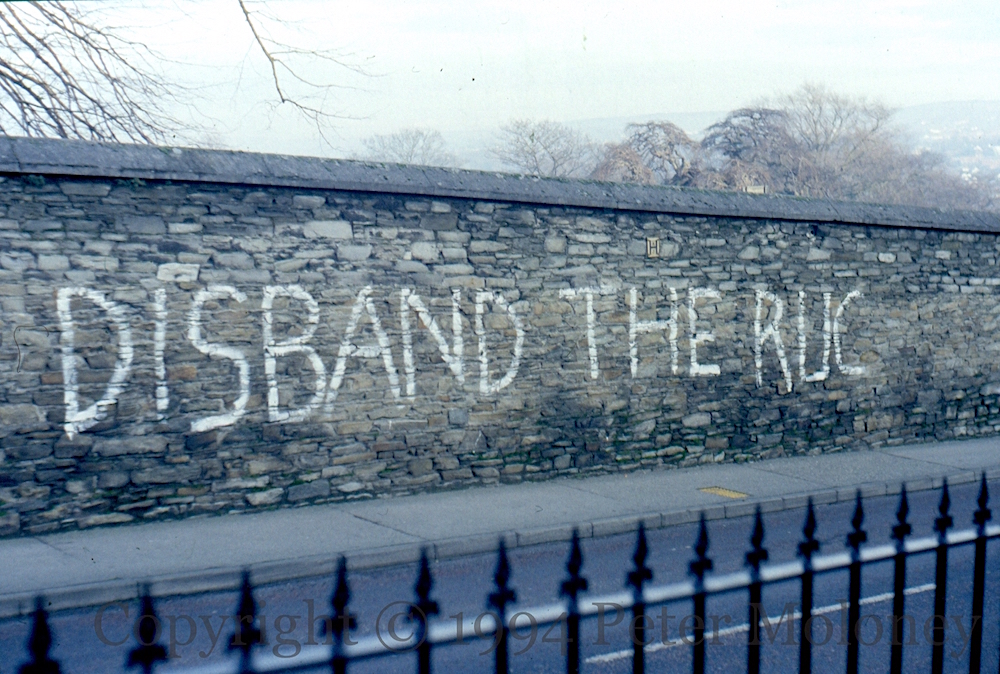
This image of a 3-in-1 RUC officer, Orange Order member, and loyalist paramilitary has been used into the era of the PSNI. Lecky Road, Derry.
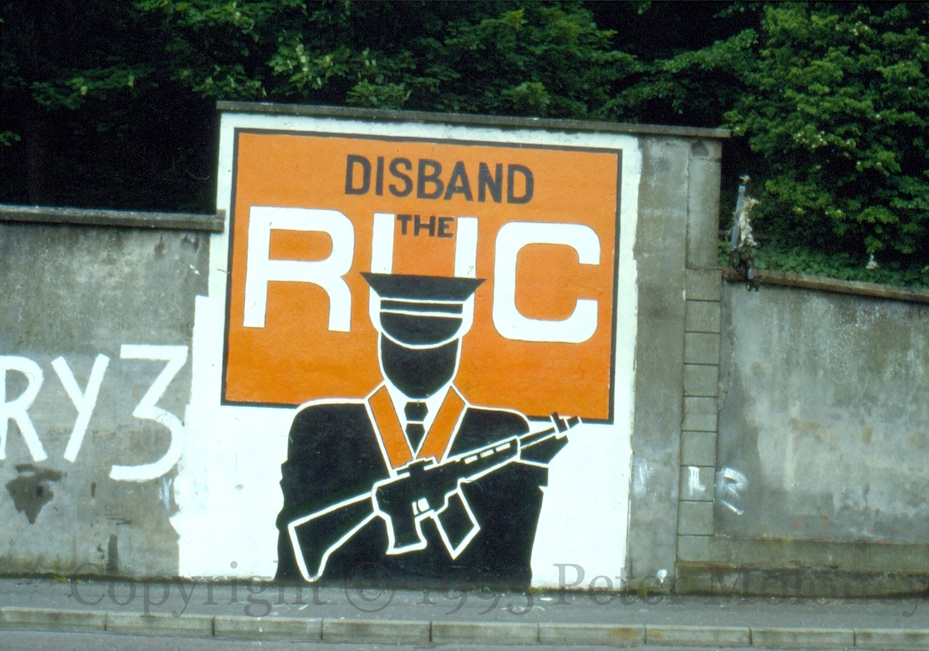
In 1995, both The Petrol Bomber (M01173) and Free Derry Corner (M01174 M01179) were given “No RUC” road signs.
“Guilty of murder, torture – disband the RUC” in the New Lodge, Belfast.
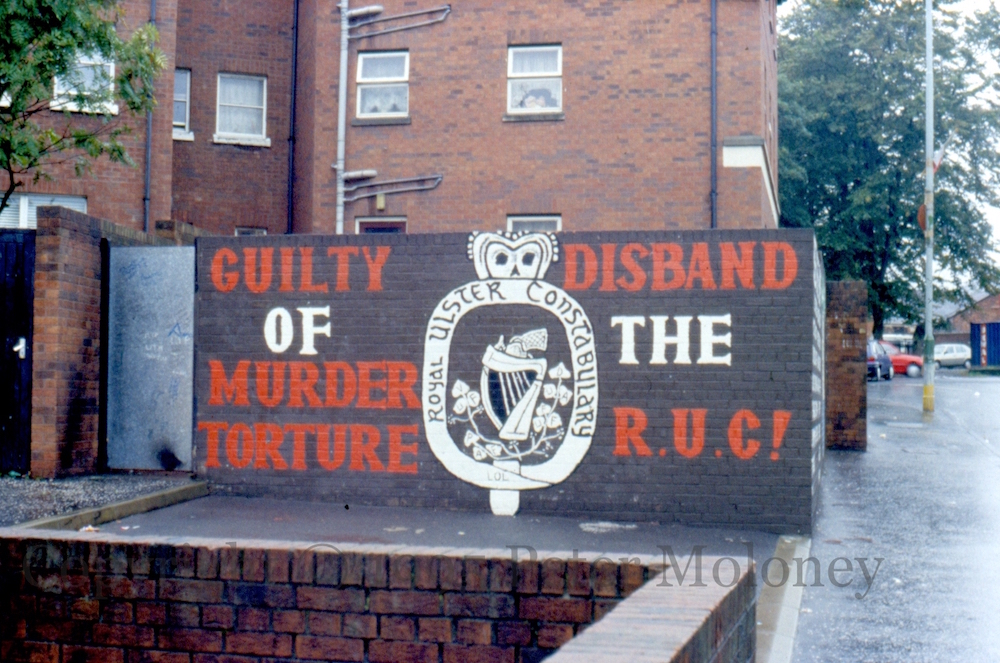
Other republican issues:
For ‘open border roads’ see M01156.
Justice for those killed by (rubber and) plastic bullets began to come to prominence. This issue would be receive more attention after the Good Friday Agreement. Examples include the Nora McCabe board that persists to the present day (2001 M01445) and ‘Ban Plastic Bullets’, a life-sized mural on what became the International Wall on Divis Street, of the distances at which victims were hit (2001 M01504). The following image is from the (CNR) New Lodge.

Throughout 1994 and 1995 the main question was whether or not Sınn Féın would be admitted to “all party” or “multi party” peace talks. As time dragged on, this did not happen and a return to war looked likely.
“All-Party Talks Now!”
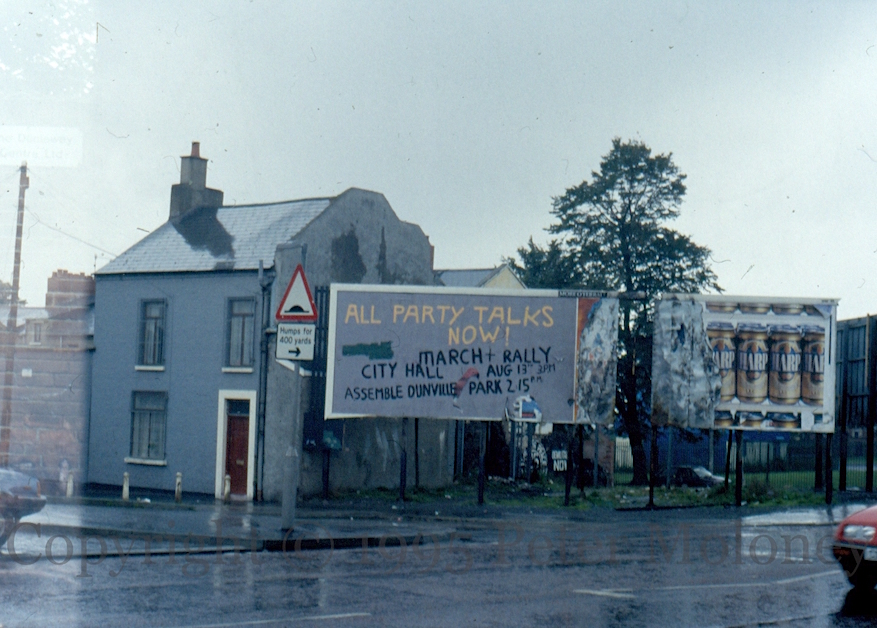
“Peace or war?” Commentary on the peace process on Derry’s bogside wall: “Peace or war?”, with an insistence on talks before decommissioning: “[Not a bullet,] Not an ounce.”

“Who really wants peace?” A dove carrying an olive branch is shackled by a British ball and chain. (As already mentioned, there is a separate Visual History page tracking the relative frequency of larks and doves.)
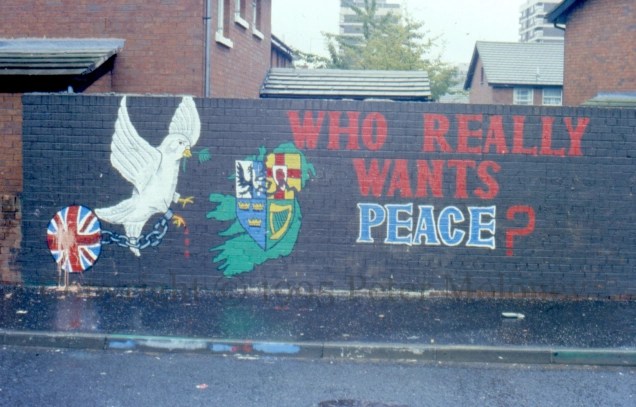
“War or peace? Britain has the choice!” Mural painted in response to the collapse of the ceasefire.

Murals about republican issues consumed much of the energy in republican muraling and as the IRA was on ceasefire, murals showing IRA weapons and volunteers in action were no longer painted. This mural in the Shantallow area of Derry is incomplete, though it is not known exactly why. The image is of a funeral volley rather than of paramilitary activity but might have nonetheless be deemed overly militaristic.
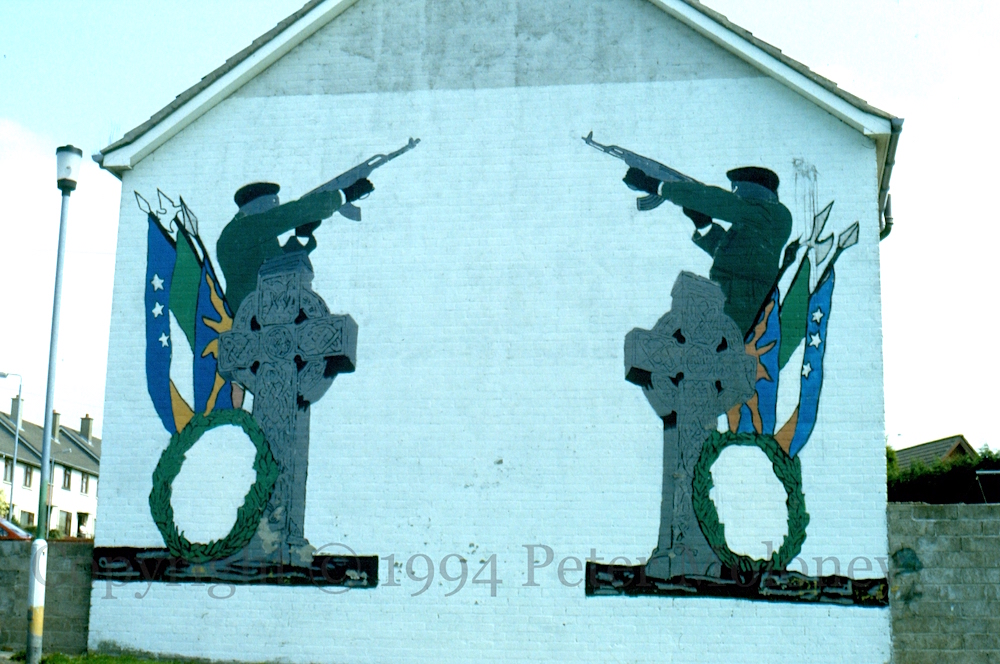
Other (“traditional”) murals of the period …
Loyalist Paramilitarism:
Brigadier John McMichael and other UDA dead, off Sandy Row, south Belfast
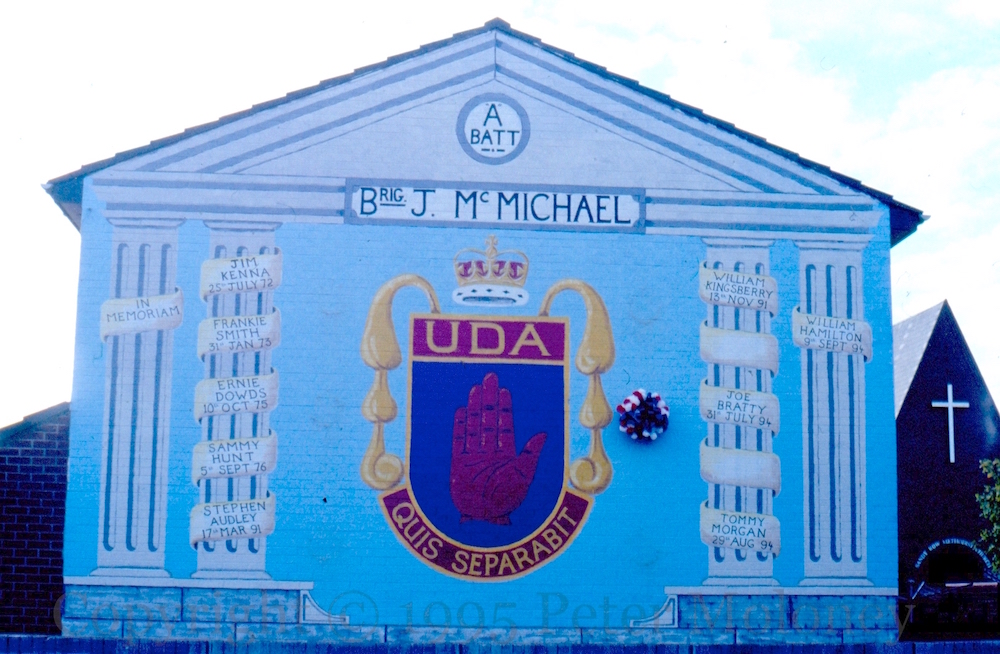
Uzis in the hands of UVF volunteers in Sandy Row, south Belfast.
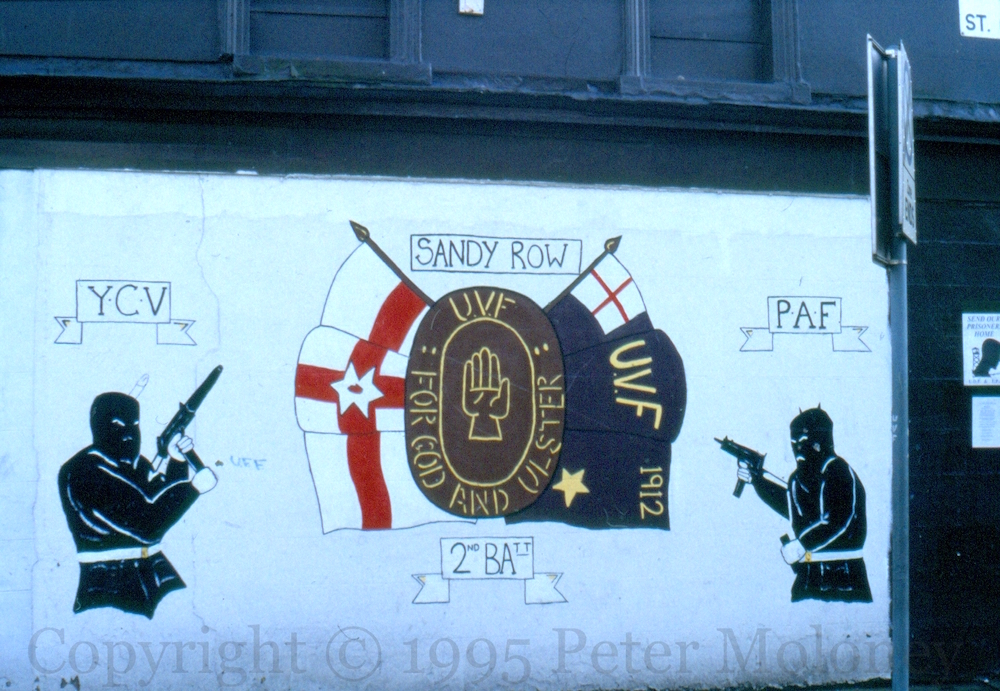
UFF assault rifle in Stroud Street, south Belfast.

King Billy:
King Billy pointing the way in Sydenham, east Belfast.
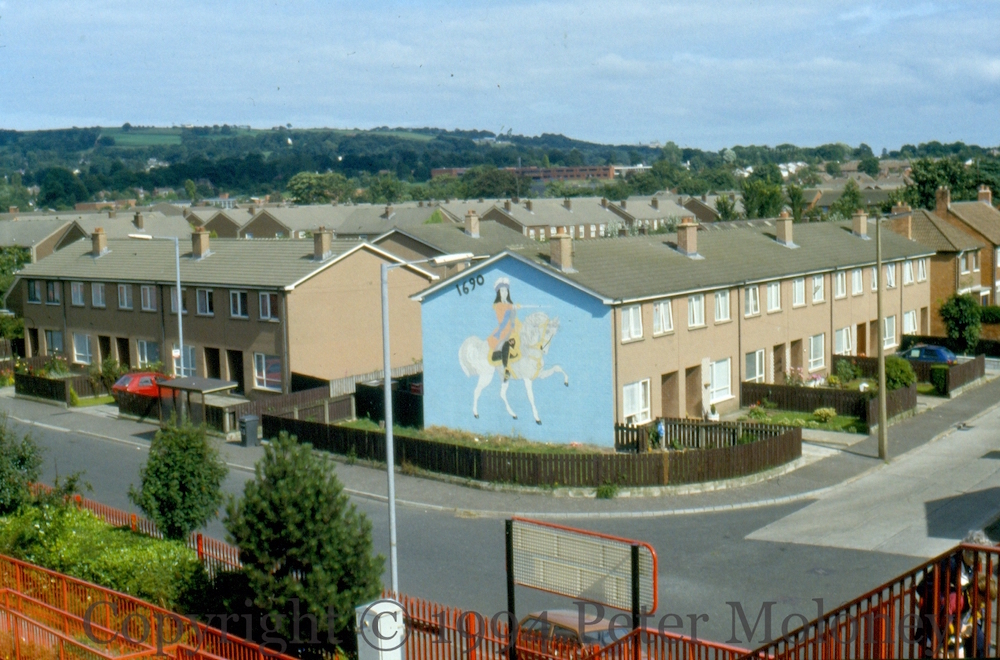
Republican History (now with increased representation of Troubles-era volunteers):
“A tribute to the heroes of 1916” in the New Lodge, north Belfast, with Cú Chulaınn in the lower right corner.
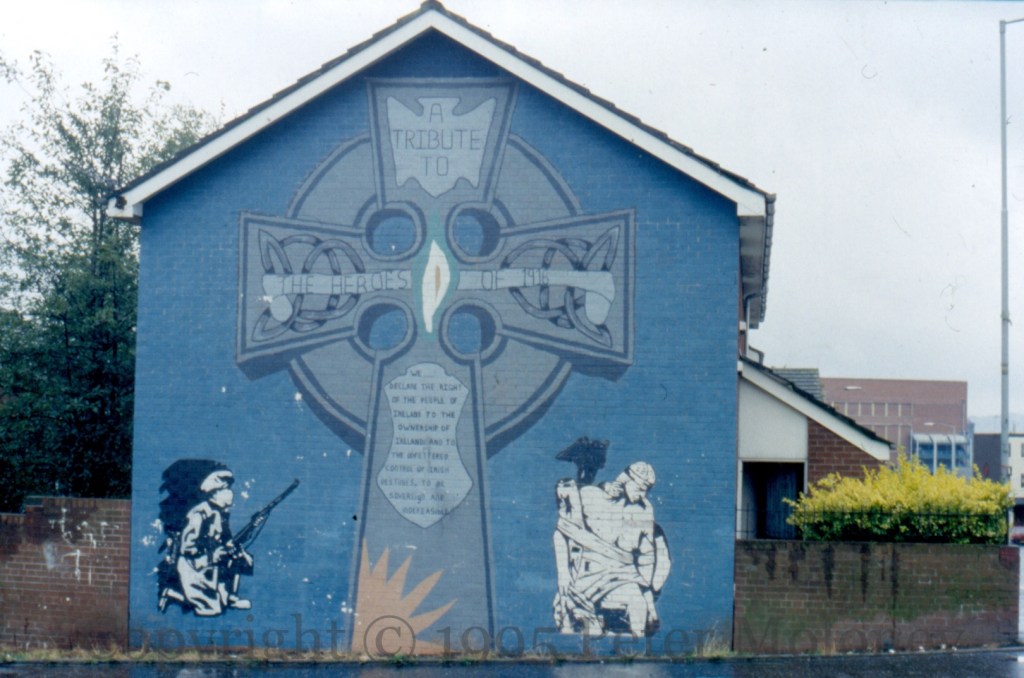
Derry Brigade roll of honour in Creggan, Derry.
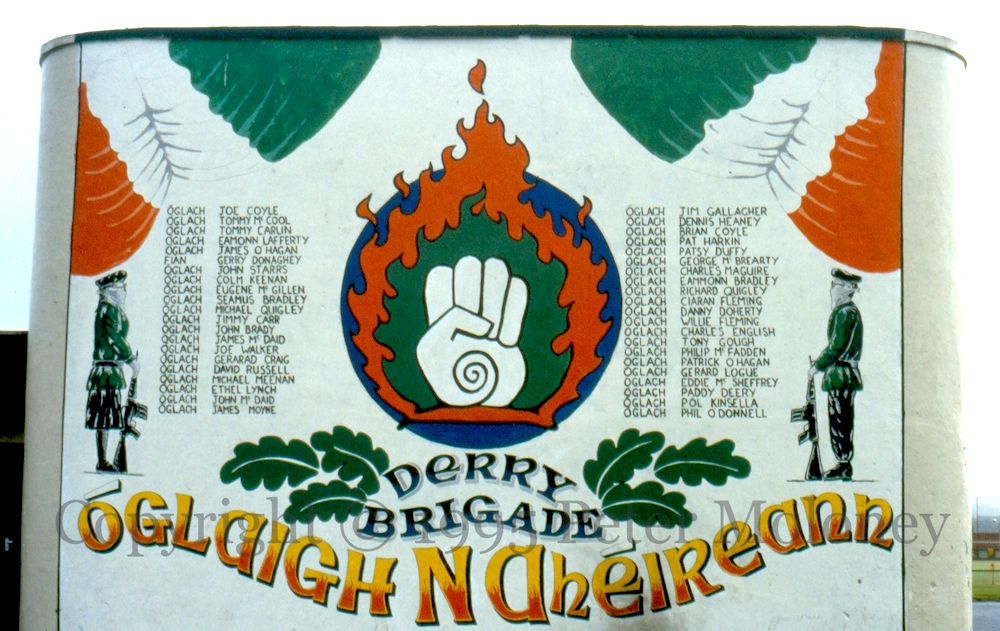
One additional theme to enter republican muraling around this time was the Great Hunger. “The great hunger” is used instead of “famine” to indicate that the cause of starvation was not scarcity of food in Ireland but rather its appropriation by British interests. (The theme has its own Visual History page.)
An tOcras Mór (New Lodge, north Belfast)

See also “There was no famine” (1995 M01217); Queen Victoria At The Seaside (1995 M01224); Ireland’s Holocaust (1995-1999 M02750). Later: Emigration Ship (1999 M02067) | Coffin Ship (2001 M01486)
A series of cultural murals (in similar ‘scene-and-border’ style to An tOcras Mór) was painted in Ardoyne: The Mass Rock (1996 M01802) | Hedge Row School (1996 M01805) | An Gorta Mór (1997 M01803)
On to Visual History 08 – The Peace Process
Reference letters for mural collections.
C = Tony Crowley Collection
D = squire93@hotmail.com collection
J = Jonathan McCormick Collection
M = Peter Moloney Collection – Murals
T = Paddy Duffy Collection
X = Seosamh Mac Coılle Collection
Back to the index of Visual History pages.
Copyright © 2018-2025 Extramural Activity. Images are copyright of their respective photographers.